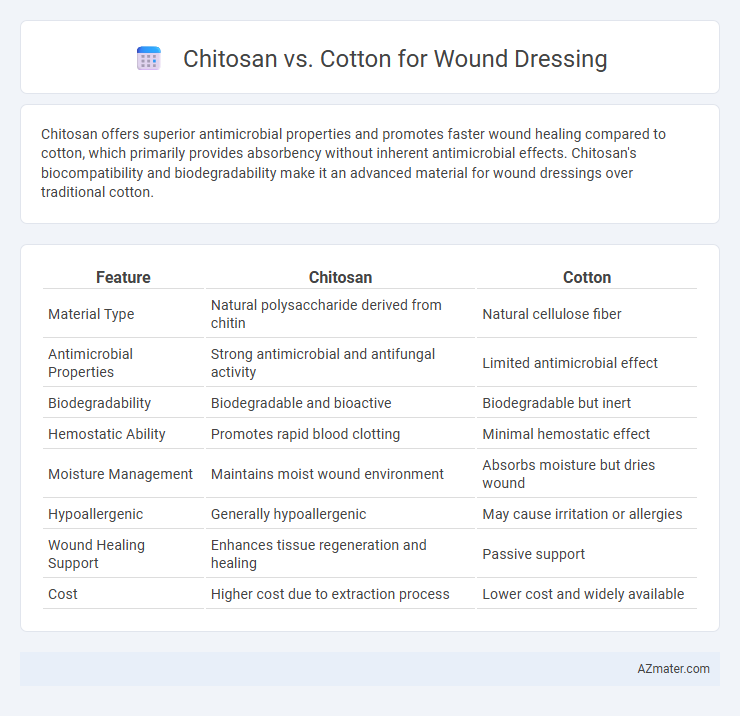Chitosan offers superior antimicrobial properties and promotes faster wound healing compared to cotton, which primarily provides absorbency without inherent antimicrobial effects. Chitosan's biocompatibility and biodegradability make it an advanced material for wound dressings over traditional cotton.
Table of Comparison
| Feature | Chitosan | Cotton |
|---|---|---|
| Material Type | Natural polysaccharide derived from chitin | Natural cellulose fiber |
| Antimicrobial Properties | Strong antimicrobial and antifungal activity | Limited antimicrobial effect |
| Biodegradability | Biodegradable and bioactive | Biodegradable but inert |
| Hemostatic Ability | Promotes rapid blood clotting | Minimal hemostatic effect |
| Moisture Management | Maintains moist wound environment | Absorbs moisture but dries wound |
| Hypoallergenic | Generally hypoallergenic | May cause irritation or allergies |
| Wound Healing Support | Enhances tissue regeneration and healing | Passive support |
| Cost | Higher cost due to extraction process | Lower cost and widely available |
Introduction: The Evolution of Wound Dressings
Chitosan and cotton represent significant milestones in the evolution of wound dressings, each offering distinct properties that influence healing outcomes. Chitosan, a biopolymer derived from chitin, exhibits remarkable antimicrobial and hemostatic effects, accelerating tissue regeneration and reducing infection risks. Cotton, a natural fiber long used for its breathability and absorbency, provides a traditional yet effective barrier that supports moisture management and patient comfort in wound care.
What is Chitosan? A Brief Overview
Chitosan is a natural polysaccharide derived from the exoskeletons of crustaceans, offering excellent biocompatibility, biodegradability, and antimicrobial properties ideal for wound dressing applications. Unlike cotton, which primarily serves as an absorbent material, chitosan actively promotes hemostasis and accelerates tissue regeneration. Its unique molecular structure enables effective moisture retention and protection against microbial infections, making it a superior choice in advanced wound care.
Properties and Composition of Cotton Dressings
Cotton wound dressings are primarily composed of natural cellulose fibers, providing high absorbency and breathability which facilitates moisture management and promotes a moist healing environment. Their soft texture minimizes skin irritation, making them suitable for sensitive or delicate skin areas. Additionally, cotton dressings offer excellent mechanical strength and flexibility, allowing for secure wound coverage and patient comfort during movement.
Antimicrobial Efficacy: Chitosan vs Cotton
Chitosan exhibits superior antimicrobial efficacy compared to cotton due to its intrinsic polycationic nature, which disrupts microbial cell membranes and inhibits bacterial growth effectively. Cotton, while widely used in wound dressings for its absorbency and breathability, lacks inherent antimicrobial properties, often requiring additional agents to prevent infection. Studies demonstrate that chitosan-based dressings significantly reduce microbial colonization and promote faster wound healing compared to traditional cotton dressings.
Biocompatibility and Safety Profiles
Chitosan exhibits superior biocompatibility due to its natural origin and ability to promote cell regeneration while maintaining antimicrobial properties, reducing infection risk in wound dressings. Cotton, although widely used, may harbor contaminants and lacks inherent antimicrobial activity, which can compromise safety and healing efficiency. The biodegradability and minimal cytotoxicity of chitosan make it a safer alternative, enhancing tissue repair with lower inflammatory responses compared to traditional cotton dressings.
Moisture Management and Healing Environment
Chitosan-based wound dressings excel in moisture management by maintaining a balanced hydrated environment that accelerates cell proliferation and reduces infection risk. Cotton dressings, while absorbent, often lack the antimicrobial properties and controlled moisture retention needed to optimize healing conditions. The biocompatibility and bioactive properties of chitosan create a superior healing environment by promoting hemostasis and tissue regeneration compared to traditional cotton materials.
Hemostatic Capabilities Compared
Chitosan exhibits superior hemostatic properties compared to cotton due to its strong positive charge, which facilitates rapid blood clotting by attracting and aggregating negatively charged red blood cells and platelets at the wound site. Cotton, primarily composed of cellulose, lacks inherent hemostatic activity and serves mainly as an absorbent material rather than actively promoting coagulation. Clinical studies demonstrate that chitosan-based dressings significantly reduce bleeding time and enhance wound healing efficiency compared to traditional cotton gauze.
Cost-Effectiveness and Availability
Chitosan wound dressings offer superior antimicrobial properties and promote faster healing but tend to be more expensive and less widely available than cotton dressings. Cotton dressings are highly cost-effective and readily accessible worldwide, making them a common choice for general wound care despite lacking advanced bioactive features. Evaluating both options requires balancing the enhanced healing benefits of chitosan against the affordability and easy procurement of cotton materials.
Clinical Applications and User Experiences
Chitosan wound dressings exhibit superior antimicrobial properties and faster hemostasis compared to cotton, leading to enhanced healing rates in clinical trials for diabetic ulcers and post-surgical wounds. Patients report reduced pain and increased comfort with chitosan products due to their biocompatibility and moisture-retentive nature, which supports tissue regeneration. In contrast, cotton dressings, while widely used for their affordability and availability, often require more frequent changing and may contribute to increased infection risk and slower wound closure.
Future Trends in Wound Dressing Materials
Chitosan-based wound dressings demonstrate superior biocompatibility, antimicrobial properties, and enhanced hemostatic effects compared to traditional cotton dressings, positioning them as a leading material in advanced wound care. Future trends emphasize integrating nanotechnology and bioactive compounds with chitosan to accelerate tissue regeneration and reduce infection rates. Emerging smart dressings combining chitosan with sensors and controlled drug delivery systems are poised to transform personalized wound management and monitoring.

Infographic: Chitosan vs Cotton for Wound Dressing
 azmater.com
azmater.com